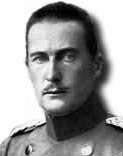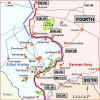First
Ypres
*
Dates: 12 Oct - 30 Nov 1914
*
Background: In the fall of 1914, after the Germans were
halted at the Marne during their initial drive on Paris, the two
warring sides
dug in at the Aisne River and then became involved in the so-called
"Race to the Sea." This was
not necessarily an attempt to be the first to reach the English
Channel, but
rather both armies were trying to outflank each other as they edged
northward toward the
sea. By October, the Allies reached the coastal town of Nieuwpoort,
Belgium.
The Germans forced the Belgian army out of Antwerp, sending it fleeing
to the
coast and then south to the western Belgian town of Ypres. The
subsequent battle lines
then settled with the BEF taking over the defense from Ypres on south
to La
Basee, France, while the French entrenched on further to the Swiss
border. The
town of Ypres was a salient bulging
eastward into German lines, and it became an important objective to
German Chief of Staff Falkenhayn's plans
for breaking through to the ports of Calais and Dunkirk. The town was
located just
east of those port cities and was also an important communications
hub. Ypres, known to the Germans as the Battle for
Calais, was also the focal point of two other major
engagements during
the war: Second Ypres (April-May 1915)
and Third Ypres, also
called Passchendaele (July-Nov 1917).
*
The Germans: There were two German
armies participating in Chief of Staff Falkenhayn's attempt to punch
through
to the Channel: Fourth Army, commanded by Duke Albrecht von
Wuerttemberg was
positioned north of Ypres, and Sixth Army, commanded by Crown Prince
Rupprecht von Bayern was south of town. Albrecht's corps commanders
included: Beseler (III. Reserves),
Falkenhayn (XXII.
Reserves), Kleist (XXIII.
Reserves), Huegel (XXVI.
Reserves), and Carlowitz (XXVII. Reserves)
who was replaced by Richard von Schubert in late October. Rupprecht's corps commanders
were: Claer (VII), Fabeck (XIII),
Laffert (XIX),
and Stein (XIV. Reserves).
Joining Rupprecht during the first week of November was Linsingen
(II),
Deimling (XV), Martini (II.
Bavarian)
and Plettenberg (Guards). Albrecht's Chief of Staff was Emit Ilse
and Rupprecht's was Konrad Krafft von Dellmensingen, both of whom were
career officers whose reputations were at stake. They had been
appointed to
ensure professional standards and were both aware that, apart from
their wish to
see a German victory, their sectors would be denied full reinforcement
and
supply if they did not succeed.
|
|

|
|
Albrecht
|
|
|
Fourth Army
|
Generalfeldmarschall
Herzog Albrecht |
|
III. Reserves |
Gen.d.Inf.
Hans von Beseler |
|
XXII. Reserves |
Gen.d.Kav.
Eugen von Falkenhausen |
|
XXIII. Reserves |
Gen.d.Kav.
Georg von Kleist |
|
XXVI. Reserves |
Gen.d.Inf.
Otto von Huegel |
|
XXVII. Reserves |
Gen.d.Inf.
Adolph von Carlowitz |
| |
* Carlowitz replaced by
Gen.d.Art. Richard von Schubert on 27 Oct |
|
Sixth Army
|
Generalfeldmarschall
Crown Prince Rupprecht |
|
VII. Corps |
Gen.d.Inf.
Eberhard von Claer |
|
XIII. Corps |
Gen.d.Inf.
Max von Fabeck |
|
XIX. Corps |
Gen.d.Kav.
Maximilian von Laffert |
|
XIV. Reserves |
GenLt.
Hermann von Stein |
| |
* arrived in
November 1916 |
|
II. Corps |
Gen.d.Inf.
Alexander von Linsingen |
|
XV. Corps |
Gen.d.Inf.
Berthold von Deimling |
|
II. Bavarian |
Gen.d.Inf. Karl Ritter
von Martini |
|
Guards Corps |
Gen.d.Inf. Karl von
Plettenberg |
* The
Battle: In early October, siege
troops of Beseler's IIIrd
Reserve Corps were transferred from Antwerp along with four newly
formed
infantry corps to join the Fourth and Sixth Armies at the Ypres
salient. The
four new corps were comprised largely of youthful, enthusiastic and
poorly
trained recruits. The battle is remembered by the Germans as Kindermord
zu
Ypern, the "massacre of innocents at Ypres." Falkenhayn
launched an initial nine-day offensive
along the northern flank of the 50-mile front in order to envelope the
BEF and seize
the Channel ports. This would not only be a significant battlefield
victory, but
it would also be significant for resupply purposes and would deny
Britain its most direct route to the continent. The BEF Old
Contemptibles
(Kaiser Wilhelm had referred to them as a "contemptible little
army") were
lead by Sir John French and were greatly outnumbered in both men -
almost 3 to 1
- as well as artillery.
The
northernmost flank was held by the Belgian army,
which had not yet recovered from its retreat from Antwerp; this part of
the
front witnessed the most intensive fighting during the battle's first
phase.
The Belgians put up much stronger resistance than had been expected but
could
not hold their position. They fell back to the Dixmude- Nieuwpoort
railway line as
the Germans crossed the Yser on 24 October. The initial German attack
was brought to a
halt when, five days later, the Belgians opened the sluice gates at
Nieuwpoort
and flooded the low-lying area.
Following
an unsuccessful Allied counterattack
during the last week of October, Falkenhayn, now under extreme pressure
to show
the Kaiser any kind of result, convinced Rupprecht to form a new Army
Group in
order to once more go on the offensive. They devised Army
Group Fabeck, lead
by XIII Corps commander Max von Fabeck. The group was comprised of
troops from
the XIII Corps, along with Martini's II Bavarian Corps transferred from
Peronne
and Deimling's XV Corps up from the Aisne. The idea was to attack where
the
Allies were the weakest: the Gheluvelt Plateau.
After achieving limited results, Falkenhayn
prepared for what would be the fourth and final phase of the battle by
adding Army
Group Linsingen to the fray: Linsingen's II Corps moved into
the Gheluvelt
area from Roye, incorporating also Deimling's XV Corps and elements
from
Plettenberg's Guard Corps in the Artois. With Messines Ridge in their
possession, there was great hope that with Linsingen's forces
concentrated along
the Menin Road, they could push through to Ypres as Fabeck was
capturing Poperinge, located further west. South of the road, the BEF
successfully
withstood continuous German attacks, but to the north Linsingen broke
through.
The Germans hesitated at this critical point, however, even though
there was
nothing in front of them apart from a thin line of British guns. |
|

|
|
Rupprecht
|
|
After achieving limited results, Falkenhayn
prepared for what would be the fourth and final phase of the battle by
adding Army
Group Linsingen to the fray: Linsingen's II Corps moved into
the Gheluvelt
area from Roye, incorporating also Deimling's XV Corps and elements
from
Plettenberg's Guard Corps in the Artois. With Messines Ridge in their
possession, there was great hope that with Linsingen's forces
concentrated along
the Menin Road, they could push through to Ypres as Fabeck was
capturing
Poperinge, located further west. South of the road, the BEF
successfully
withstood continuous German attacks, but to the north Linsingen broke
through.
The Germans hesitated at this critical point, however, even though
there was
nothing in front of them apart from a thin line of British guns.
In the end,
there was to be no decisive success
for Falkenhayn, the heavy rains and snows bringing First Ypres to a
close. The outnumbered BEF suffered heavy
casualties, reduced to half of its original strength, but the line was
held. This battle
marked the end of open warfare on
the Western Front as the two sides entrenched themselves along a
600-mile line,
stretching from
the North Sea to the Swiss Alps. German casualties at First Ypres are
estimated
at well over 130,000.

* click to
enlarge
home


